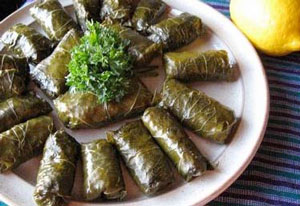
Iranian cuisine is often called Persian since the country was actually Persia until 1934. The food is a combination of lots of spicy curry stews with other dishes as diverse as kofta (meatballs) or pilau – all common to Iranian cuisine. Several of Iran's dishes also come from the Greeks, Arabs, Turks, and Russians.
Take for example the popular dolma or stuffed grape leaves, often seen on many a Greek menu, it’s now a popular and well-loved dish in Iran. Other foods common to the Iranian cuisine include yogurt, lamb, dates, and figs, which all came into the Persian diet during the Arab invasion in the 600s.
On the website bestintravel.com, it is noted, “Iran was the first country to use many common herbs such as basil, mint, cumin, cloves, and coriander. Many different foods originated or [were initially] introduced in Iran such as oranges, pistachios, spinach, saffron, sweet and sour sauces, kebabs, and almond pastries.”
One very important staple in the Iranian diet is the kebab (skewered meat), normally chicken or lamb, which the Turks introduced, and is so well loved that it is an Iranian national dish.
Of course, the food in Iran is also diverse and reflects the various regions within the country. While often considered "Middle Eastern," Iranian cuisine goes much deeper. For example, Iranian food offers a contrast of flavors that includes both sweet and sour, or mild and spicy flavoring with a lot of rice, which in turn, sets it apart from other Middle Eastern styles of foods.
A normal Iranian meal consists of cooked rice with vegetables, fish, meat, and nan (bread), baked or cooked over a bed of small stones. Iran hosts a number of pastries and drinks specific to the country, such as the doogh, which consists of yogurt, water, and dried mint. Another favorite is havij bastani: carrot juice served as an ice cream float with the added flavoring of cinnamon or nutmeg.
Dessert normally includes fruits such as quinces, pears, grapes, or apricots, and the dessert baklavai (a pastry layered with nuts and honey) is another option for special occasions. No matter the food, it is a fact that most Iranians must have is their chây (tea). The strong, dark tea is brewed in an urn called a samovar and served at every meal.
Iranians serve their meals in family style, and expect guests to offer a gift upon arriving into the home, or extend a return dinner invitation to the host. A table cloth used to cover the floor rug is then filled with large dishes piled high with food. When eating, sit cross-legged in front of the individual settings of plates, bowls, fork, and spoon. Men and women sit separately unless related while eating and talking is minimal during all meals.
As for who does the cooking in the Iranian home, women have had a great influence in the history of cooking in Iran. Acording to the website, www.cultureofiran.com, “The best chefs were and still are women, from the palaces of the Persian kings, to the average housewife, women have fabulous skills preparing exquisite cuisine.”
Men do not cook in Iran – it is unheard of and Iranians do not think that restaurants are as good as homemade food, so Iranians eat most meals at home. Although few, the available Iranian restaurants do not normally offer Iranian cuisine, and if they do, it normally includes the rice and kebabs option.
 Dolma or Stuffed Grape Leaves (Recipe taken from www.foodbycountry.com/Iran)
Dolma or Stuffed Grape Leaves (Recipe taken from www.foodbycountry.com/Iran)
This recipe makes about 25 stuffed grape leaves.
Ingredients
1 jar grape leaves
1½ cups uncooked rice
1 medium onion, diced
¼ cup olive oil
2 cups water
½ cup fresh parsley, chopped
2 Tablespoons fresh dill, chopped
1 teaspoon fresh mint, chopped
¼ cup feta cheese, crumbled
½ cup pine nuts
½ cup raisins
½ cup lemon juice
Salt and pepper, to taste
Procedure
In a saucepan, sauté the onion in olive oil until light brown. Add rice and brown lightly. Add the water, salt, and pepper. Bring the water to a boil and simmer for five to seven minutes or until water is absorbed but rice is only partially cooked. Make sure the rice does not stick or burn. Add all the ingredients except the lemon juice and mix well. Drain the grape leaves and place 1 Tablespoon of filling in the center of each leaf. Fold the sides in and roll the leaf up.
Place stuffed leaves in a pot in even and tight rows covering the bottom of the pan. When the bottom layer is complete, start another layer. Continue rolling dolmas until all of the filling is used. Add ½ of the lemon juice and enough water to cover half of the rolled leaves. Place a plate on the top layer to hold the stuffed leaves down and to prevent them from unrolling while cooking. Simmer over low heat until most of the liquid is absorbed, about 45 minutes. Remove the plate and dolmas from the pan, drizzle with olive oil and lemon juice, and serve.
Sources:
www.Bestirantravel.com
http://www.foodbycountry.com/Germany-to-Japan/Iran.html
http://www.destinationiran.com/eat-in-iranian-restaurants-visit-of-iran.htm
www.cultureofiran.com
